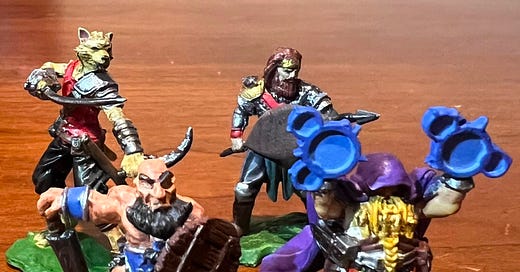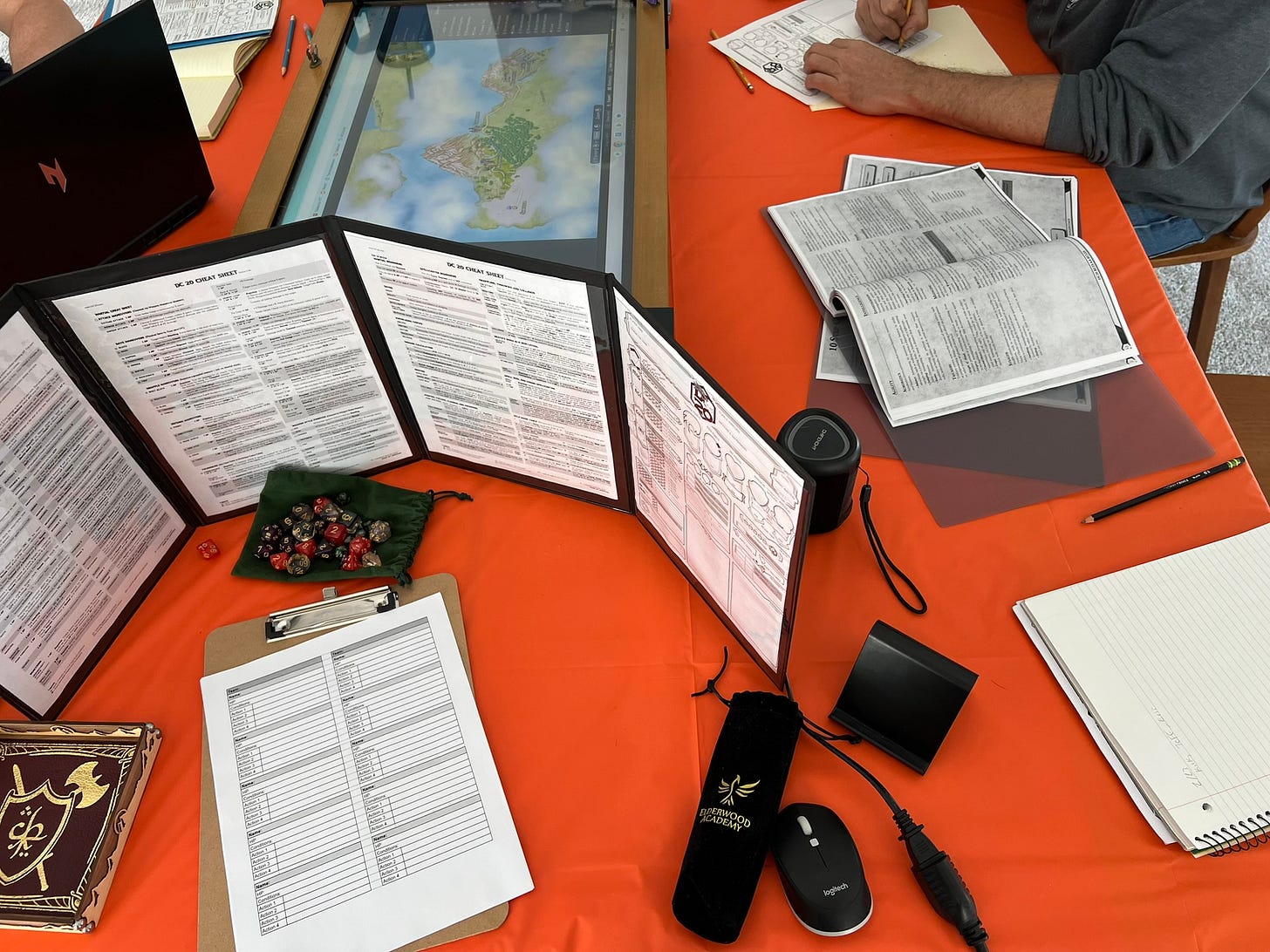Mission Accomplished
I ran my first DC20 session this past Sunday, and it went really well! The group really enjoyed the new system, especially the action point-based combat.
I also wanted to introduce something new to the table—literally. This was our first time using a Virtual Tabletop (VTT), along with some custom-painted minis I had prepared for the party. It added an extra layer of immersion and excitement to the game!
Getting Ready
Heading into the session was nerve-wracking. It had been so long since I’d run a game, and this time, I was tackling a brand-new system with DC20. Despite all the hours I’d spent poring over the rules, prepping materials, and organizing everything down to the last detail, doubts still crept in. Would I remember all the system’s nuances? Would I fumble a rule at a crucial moment? More than anything, I didn’t want to let my friends down—especially our usual DM, who had put his trust in me to run a great game.
Just as those nagging worries started to take hold, I reminded myself of something Gary Gygax once said:
“It is the spirit of the game, not the letter of the rules which is important.”
Our Adventure
This was our group’s first time using a Virtual Tabletop (VTT) for a session, which added a new layer of excitement—and a bit of a learning curve. Fortunately, the module’s maps were straightforward and didn’t require any complex fog-of-war mechanics to hide sections from the players. Still, I experimented with it a little to get a feel for how it might enhance future scenarios.
To bring even more life to the game, I went the extra mile by buying, painting, and customizing miniature figures for the group. It was a small detail, but one that added a tangible, personal touch to the session. Plus, I had a blast painting them—it felt like crafting a little piece of the world we were about to dive into.
One of the things I really enjoyed about the introductory module was how well it encouraged roleplay. It also helped that one of my players was deeply invested in crafting a rich backstory for his character, Cram. That gave us the perfect opportunity to weave the module’s antagonist, Raven, into his past, adding a personal and dramatic touch to the story.
Before diving into the adventure, we took the time to establish connections between the characters, ensuring they had meaningful ties to one another. With that foundation in place, we kicked off "The Hunted." The premise was simple but compelling: the group sought to join an elite band of monster hunters known as The Bloodsworn, chasing fame, fortune, and glory. Their first mission? Claim a bounty by hunting down The Skitter, a dangerous monster.
But they weren’t the only ones after the prize. Another faction, The Shadows, led by none other than Raven, was determined to beat them to it. This set the stage for a tense rivalry, culminating in a clash between the two groups. And if they managed to overcome The Shadows, an even greater threat awaited—the true monster of the module, a terrifying Krasis.
The session began by immersing the players into the rich tapestry of our world. To familiarize them with the unique mechanics of DC20, we embarked on a series of challenges interwoven with extensive world-building and role-play. Cram's intricate backstory provided ample opportunities to weave in subtle references during NPC interactions, adding depth to the narrative.
The first challenge required the team to demonstrate their worthiness to join the esteemed Bloodsworn. My players eagerly showcased a variety of maneuvers, fully embracing the dynamic combat system. Purrinir, our agile feline Beastborn, leaped onto a combat dummy, delivering a devastating disembowelment in a single, fluid motion.
With this trial behind them, the group set off to claim their bounty. En route, they encountered Raven and The Shadows, presenting a prime opportunity for improvisation between her and Cram. Their exchange was laced with mature, intense banter, adding a palpable tension to the storyline.
The subsequent encounter with The Skitter was designed as a combat challenge, where players narrated their actions without rolling dice. In hindsight, this approach felt somewhat lacking. While it encouraged creative role-play, the absence of dice rolls diminished the element of unpredictability and excitement that typically fuels our sessions. Moving forward, I plan to integrate more interactive combat scenarios that balance narrative flair with the thrill of chance.
After swiftly dispatching The Skitter, our group eagerly anticipated their first true taste of DC20 combat. As four members of The Shadows emerged, intent on seizing the bounty, the atmosphere crackled with tension. "Roll for Initiative!" I declared, signaling the commencement of battle.
The ensuing combat was exhilarating. The players enthusiastically explored the system's diverse actions, while I endeavored to manage the dynamic flow. The team performed admirably, eliminating three adversaries and leaving only Nymessa, a formidable Fiendborn, standing. Desiring to preserve her for future narrative threads, I ensured the players restrained her and began escorting her back to town.
However, their journey was abruptly interrupted by the formidable Krasis. This subsequent encounter proved both smoother in execution and more challenging in intensity. Two party members teetered on the brink of death before the creature was vanquished, allowing the weary adventurers to return to town, victorious yet battle-worn.
During the session, I introduced a whimsical pair of magic socks, hoping the players would try them on and discover their enchantment. Instead, they grew suspicious, pondering how a monster came to possess such an item and what the symbol on its container might signify—none of which I had anticipated. I improvised with a few vague hints, which satisfied their curiosity for the moment, though the socks remained unworn.
At the outset of this adventure, I laid the groundwork for our next campaign: "The Shade Willow" from DC20 Magazine #5. Now, I need to creatively incorporate the mysterious socks into that storyline.
What we liked
DC20 offers a wealth of features that enhance the tabletop role-playing experience. One standout aspect is its versatility in character creation. Unlike traditional systems where races come with predefined traits, DC20 provides players with five points to allocate among various ancestry traits, allowing for highly personalized characters. This flexibility extends to dual ancestry options, enabling combinations like a Dwarven Gnome with selected traits from both lineages.
The action points system further enriches gameplay by granting each character four action points per turn, which can be spent on a variety of actions both on and off their turn. This dynamic approach keeps players engaged and encourages creative strategies. Additionally, martial characters have access to a diverse array of maneuvers, offering a level of versatility comparable to the spell choices available to magic users.
What could have gone better
While DC20 offers a wealth of versatility and dynamic gameplay, it's not without its challenges. As the system is still in beta, player materials aren't widely accessible. To bridge this gap, I printed some resources, but there weren't enough copies for everyone. The most daunting aspect was managing the extensive information: numerous actions available to NPCs, various conditions affecting them, and the unique nuances of each weapon. To stay organized, I prepared sheets in advance to track these details for both PCs and NPCs, though this proved time-consuming. Additionally, I found the combat challenges less engaging, and my players seemed to agree. While they might be useful for some GMs, I prefer traditional combat encounters.
What I’ll do different next time
To enhance future sessions, I plan to prepare combat scenarios more thoroughly in advance. Familiarizing myself with key actions and the specific features of weapons will streamline gameplay and make combat encounters more fluid. Additionally, as my players have now gained experience with the system, they're better equipped to manage their actions and conditions, which should further enhance the overall gaming experience.





